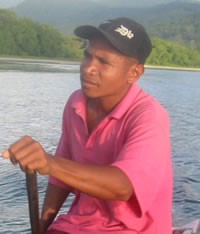Galeya in Papua New Guinea

Photo Source:
Anonymous
|
Send Joshua Project a map of this people group.
|
| People Name: | Galeya |
| Country: | Papua New Guinea |
| 10/40 Window: | No |
| Population: | 4,400 |
| World Population: | 4,400 |
| Primary Language: | Galeya |
| Primary Religion: | Christianity |
| Christian Adherents: | 90.00 % |
| Evangelicals: | 21.00 % |
| Scripture: | Translation Started |
| Ministry Resources: | No |
| Jesus Film: | No |
| Audio Recordings: | Yes |
| People Cluster: | New Guinea |
| Affinity Bloc: | Pacific Islanders |
| Progress Level: |
|
Introduction / History
The Galeya people live on Fergusson Island in Milne Bay Province, Papua New Guinea. There are approximately 170 Galeya villages, most with less than 10 houses. Half of the villages are coastal, and half are in the mountains. Galeyans cultivate crops such as yams, bananas, and pineapples, primarily for personal consumption. Some produce is sold at local markets. Fresh fish supplements coastal villages' diets. Houses are constructed on posts 5 or 6 feet above the ground. The floor and walls are made of palm wood, and palm leaves form the roofs. Most people wear modern clothing, although a few girls and women still wear grass skirts.
The first missionary to the Galeya area was Dr. William E. Bromilow, of the Methodist Church, who briefly visited the Galeya people in the late 19th century. Tradition holds that a fierce Galeya warrior named Kwaredi was a leader in tribal warfare before Bromilow's arrival. Bromilow wanted to end warfare and cannibalism in the area, so he paid a visit to Kwaredi, bringing gifts - a stick of tobacco and a white cloth, symbolizing light and the end of war. The missionary tied the cloth around Kwaredi's waist, prayed with the people, and then left them. Reportedly, Bromilow's visit marked the end of fighting in the Galeya area. There was a second wave of missionaries in the 20th century, who came to plant churches. Between the 1930s and 1950s, there were three influential missionaries from the neighboring Dobu language group. Thus, the heritage of the Galeya churches rests largely upon Dobu roots.
To this day, the Dobu language plays a prominent role in Galeya churches. There is a Dobu Bible, which is frequently used in church, however, most Galeyans do not speak Dobu well enough to understand Dobu Scriptures. Although many Galeya people claim to be Christians, many are only nominal. Some profess Christianity while still practicing elements of their traditional religion, such as sorcery.